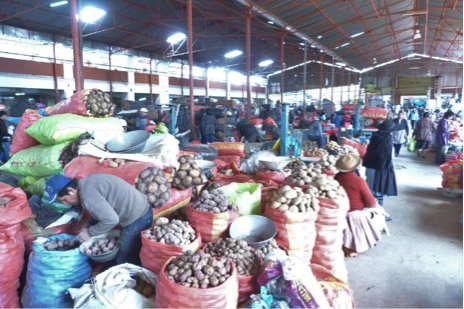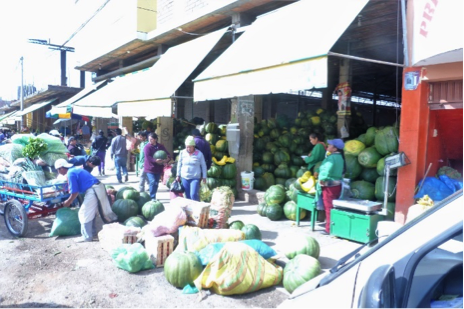1.2.4.5: 5. Diversified Smallholder Production in the Peruvian Andes- Local to Regional - Option 2
- Page ID
- 48055
Overview
In contrast to the highly specialized and industrialized production of Peruvian asparagus for the global market (above), smallholders in the Andean Mountains of Peru integrate a wide variety of livestock and crop types on their farms, from llamas to sheep to dairy cattle, and from native potato varieties to maize as well as legume grains and forages and vegetables. They also place a high priority on self-sufficiency in many food crops, balanced with sales to local (e.g. within community barter and purchase on community market days) and regional (e.g. wholesale to regional intermediary buyers and markets, Fig. 1.2.11). The variety of crops, livestock, and production is partly explained by the varied elevation and soil types found in the mountainous Andean environment. A high diversity of products, production strategies, and market versus consumption destinations for agricultural production has thus emerged in modern Andean societies as a way to adapt to both the natural risks of a mountain environment (e.g. drought, frost, hail) and the opportunities and challenges of a complex and fluctuating market that very often does not favor the farmer’s interests.


Figure 1.2.11.: Two market scenes for regional distribution of local smallholder production in the Central Andes of Peru: Potatoes (top) and squash (bottom). Credit: Steven Vanek
The integration of small livestock herds in these systems is very important and allows farmers higher value products such as wool and meat that can be used for short-term cash needs. Grazing livestock also allows them to “harvest” manure nutrients via grazing on high-altitude grasslands. When animals are penned into night-time corral areas they produce manure that is stored for use in fertilizing crop fields. Farmers also apply limited amounts of modern chemical fertilizers to their crops, especially those destined for regional markets. Increasingly, farm communities are banding together using strong and complex community government schemes to win government funding for and build community-wide irrigation schemes that are fed by mountain stream systems. These irrigation systems, some very extensive, are used for adaptation to drought years, expansion of cultivated land or irrigation of fodder crops to feed animals year-round in small intensified dairy schemes. The expansion of small dairy enterprises has been driven by increases in the price of milk in Andean countries from growing urban populations. Because of the preponderance of sloped land in these mountain systems, soil productivity for these Andean smallholders is very vulnerable to erosion during the intense rainy season of the Central Andes. Climate change has also tended to accentuate the severity of climate risks in these systems.


